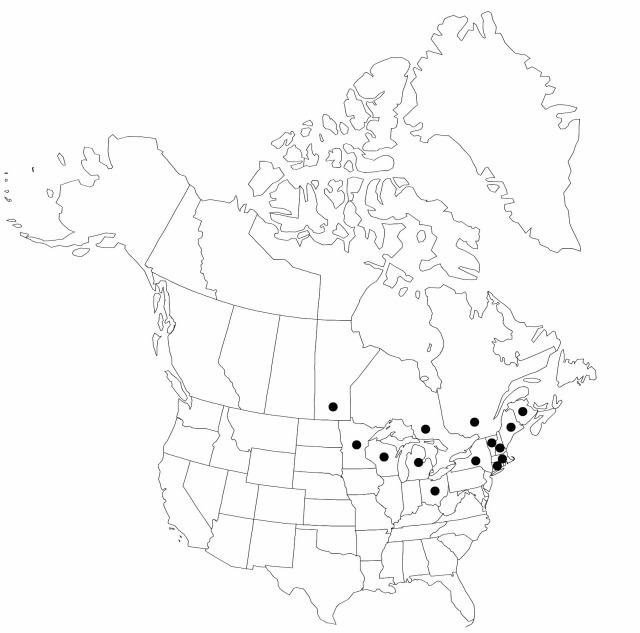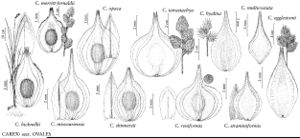Difference between revisions of "Carex merritt-fernaldii"
Bull. Torrey Bot. Club 49: 370. 1923.
FNA>Volume Importer |
imported>Volume Importer |
||
| (3 intermediate revisions by 2 users not shown) | |||
| Line 8: | Line 8: | ||
}} | }} | ||
|common_names=Carex de Fernald | |common_names=Carex de Fernald | ||
| + | |special_status={{Treatment/ID/Special_status | ||
| + | |code=F | ||
| + | |label=Illustrated | ||
| + | }}{{Treatment/ID/Special_status | ||
| + | |code=E | ||
| + | |label=Endemic | ||
| + | }} | ||
|basionyms= | |basionyms= | ||
|synonyms={{Treatment/ID/Synonym | |synonyms={{Treatment/ID/Synonym | ||
|name=Carex brevior var. pseudofestucacea | |name=Carex brevior var. pseudofestucacea | ||
|authority=Farwell | |authority=Farwell | ||
| + | |rank=variety | ||
}} | }} | ||
|hierarchy=Cyperaceae;Carex;Carex sect. Ovales;Carex merritt-fernaldii | |hierarchy=Cyperaceae;Carex;Carex sect. Ovales;Carex merritt-fernaldii | ||
| Line 35: | Line 43: | ||
-->{{#Taxon: | -->{{#Taxon: | ||
name=Carex merritt-fernaldii | name=Carex merritt-fernaldii | ||
| − | |||
|authority=Mackenzie | |authority=Mackenzie | ||
|rank=species | |rank=species | ||
| Line 49: | Line 56: | ||
|publication title=Bull. Torrey Bot. Club | |publication title=Bull. Torrey Bot. Club | ||
|publication year=1923 | |publication year=1923 | ||
| − | |special status= | + | |special status=Illustrated;Endemic |
| − | |source xml=https:// | + | |source xml=https://bitbucket.org/aafc-mbb/fna-data-curation/src/2e0870ddd59836b60bcf96646a41e87ea5a5943a/coarse_grained_fna_xml/V23/V23_663.xml |
|genus=Carex | |genus=Carex | ||
|section=Carex sect. Ovales | |section=Carex sect. Ovales | ||
Latest revision as of 20:42, 5 November 2020
Plants densely cespitose; rhizomes appearing elongate only in old clumps. Culms 30–100 cm; vegetative culms few, inconspicuous, with fewer than 15(–17) leaves, not strikingly 3-ranked. Leaves: sheaths adaxially white-hyaline, summits U-shaped to truncate, sometimes prolonged 1–2 mm beyond collar, not puckered, finely papillose; distal ligules 2.5–4.8 mm; blades 3–6 per fertile culm, 14–32 cm × 1.5–3 mm. Inflorescences compact to open, occasionally elongate and arching or nodding, reddish brown or straw colored, 1.5–5 cm × 7–15 mm; proximal internode 5–15 mm; 2d internode 3–7 mm; proximal bracts scalelike with bristle tips shorter than inflorescences. Spikes (4–)6–8(–10), distinct, ovoid, 7–15 × 5–9 mm, base rounded, apex rounded or nearly acute. Pistillate scales light yellow-brown with paler midvein, lance-subulate or lanceolate, occasionally broadly lanceolate, (3.2–)3.4–3.8(–4.2) mm, 0.2–1.3 mm shorter than perignyium beaks, narrower than perigynia, margins white-hyaline, 0.1–0.3 mm wide, apex acute. Anthers 1.3–2.6 mm. Perigynia 15–80 in larger spikes, ascending, light green to straw colored, conspicuously 5–9-veined abaxially, veinless or faintly 1–5-veined adaxially, broadly ovate to ovate-orbiculate, plano-convex, 3.3–5 × 2.3–3.5 mm, 0.5–0.8 mm thick, irregular, margin flat, including wing 0.4–0.8 mm wide, with 1–2 veins in yellowish wing, smooth; beak red-brown at tip, flat, 0.7–1.6(–1.8) mm, ciliate-serrulate, abaxial suture ± conspicuous, distance from beak tip to achene 1.8–3.1 mm. Achenes ovate or orbiculate, 1.4–1.8 × 1.1–1.5 mm, 0.5–0.7 mm thick. 2n = 70, 74.
Phenology: Fruiting early–mid summer.
Habitat: Dry sands, gravels, rocky places, meadows, roadsides, on acidic substrates
Elevation: 50–600 m
Distribution

Man., N.B., Ont., Que., Conn., Maine, Mass., Mich., Minn., N.H., N.Y., Ohio, Vt., Wis.
Discussion
Selected References
None.
